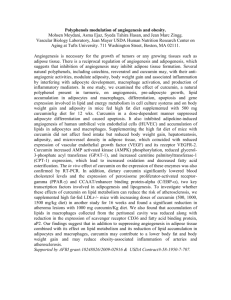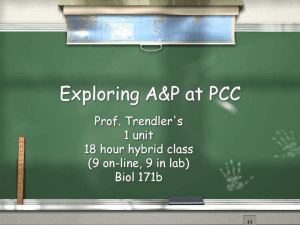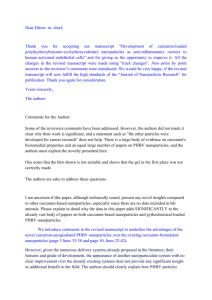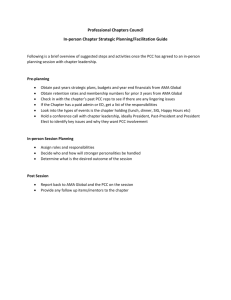Document 13309071
advertisement
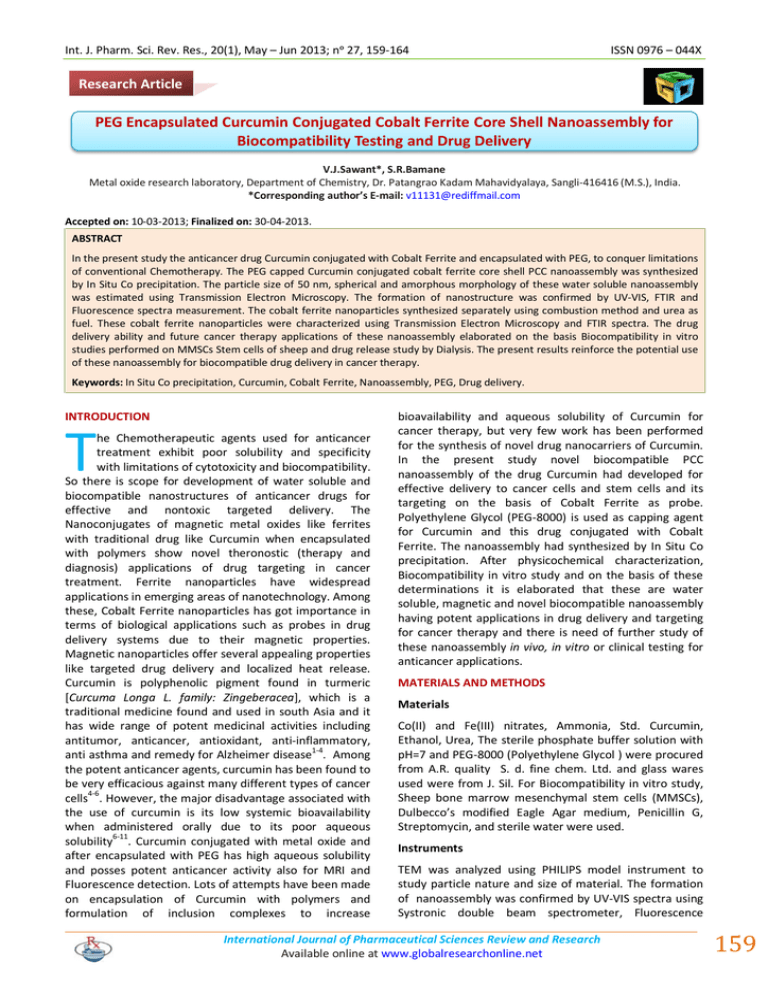
Int. J. Pharm. Sci. Rev. Res., 20(1), May – Jun 2013; nᵒ 27, 159-164 ISSN 0976 – 044X Research Article PEG Encapsulated Curcumin Conjugated Cobalt Ferrite Core Shell Nanoassembly for Biocompatibility Testing and Drug Delivery V.J.Sawant*, S.R.Bamane Metal oxide research laboratory, Department of Chemistry, Dr. Patangrao Kadam Mahavidyalaya, Sangli-416416 (M.S.), India. *Corresponding author’s E-mail: v11131@rediffmail.com Accepted on: 10-03-2013; Finalized on: 30-04-2013. ABSTRACT In the present study the anticancer drug Curcumin conjugated with Cobalt Ferrite and encapsulated with PEG, to conquer limitations of conventional Chemotherapy. The PEG capped Curcumin conjugated cobalt ferrite core shell PCC nanoassembly was synthesized by In Situ Co precipitation. The particle size of 50 nm, spherical and amorphous morphology of these water soluble nanoassembly was estimated using Transmission Electron Microscopy. The formation of nanostructure was confirmed by UV-VIS, FTIR and Fluorescence spectra measurement. The cobalt ferrite nanoparticles synthesized separately using combustion method and urea as fuel. These cobalt ferrite nanoparticles were characterized using Transmission Electron Microscopy and FTIR spectra. The drug delivery ability and future cancer therapy applications of these nanoassembly elaborated on the basis Biocompatibility in vitro studies performed on MMSCs Stem cells of sheep and drug release study by Dialysis. The present results reinforce the potential use of these nanoassembly for biocompatible drug delivery in cancer therapy. Keywords: In Situ Co precipitation, Curcumin, Cobalt Ferrite, Nanoassembly, PEG, Drug delivery. INTRODUCTION T he Chemotherapeutic agents used for anticancer treatment exhibit poor solubility and specificity with limitations of cytotoxicity and biocompatibility. So there is scope for development of water soluble and biocompatible nanostructures of anticancer drugs for effective and nontoxic targeted delivery. The Nanoconjugates of magnetic metal oxides like ferrites with traditional drug like Curcumin when encapsulated with polymers show novel theronostic (therapy and diagnosis) applications of drug targeting in cancer treatment. Ferrite nanoparticles have widespread applications in emerging areas of nanotechnology. Among these, Cobalt Ferrite nanoparticles has got importance in terms of biological applications such as probes in drug delivery systems due to their magnetic properties. Magnetic nanoparticles offer several appealing properties like targeted drug delivery and localized heat release. Curcumin is polyphenolic pigment found in turmeric [Curcuma Longa L. family: Zingeberacea], which is a traditional medicine found and used in south Asia and it has wide range of potent medicinal activities including antitumor, anticancer, antioxidant, anti-inflammatory, anti asthma and remedy for Alzheimer disease1-4. Among the potent anticancer agents, curcumin has been found to be very efficacious against many different types of cancer cells4-6. However, the major disadvantage associated with the use of curcumin is its low systemic bioavailability when administered orally due to its poor aqueous solubility6-11. Curcumin conjugated with metal oxide and after encapsulated with PEG has high aqueous solubility and posses potent anticancer activity also for MRI and Fluorescence detection. Lots of attempts have been made on encapsulation of Curcumin with polymers and formulation of inclusion complexes to increase bioavailability and aqueous solubility of Curcumin for cancer therapy, but very few work has been performed for the synthesis of novel drug nanocarriers of Curcumin. In the present study novel biocompatible PCC nanoassembly of the drug Curcumin had developed for effective delivery to cancer cells and stem cells and its targeting on the basis of Cobalt Ferrite as probe. Polyethylene Glycol (PEG-8000) is used as capping agent for Curcumin and this drug conjugated with Cobalt Ferrite. The nanoassembly had synthesized by In Situ Co precipitation. After physicochemical characterization, Biocompatibility in vitro study and on the basis of these determinations it is elaborated that these are water soluble, magnetic and novel biocompatible nanoassembly having potent applications in drug delivery and targeting for cancer therapy and there is need of further study of these nanoassembly in vivo, in vitro or clinical testing for anticancer applications. MATERIALS AND METHODS Materials Co(II) and Fe(III) nitrates, Ammonia, Std. Curcumin, Ethanol, Urea, The sterile phosphate buffer solution with pH=7 and PEG-8000 (Polyethylene Glycol ) were procured from A.R. quality S. d. fine chem. Ltd. and glass wares used were from J. Sil. For Biocompatibility in vitro study, Sheep bone marrow mesenchymal stem cells (MMSCs), Dulbecco’s modified Eagle Agar medium, Penicillin G, Streptomycin, and sterile water were used. Instruments TEM was analyzed using PHILIPS model instrument to study particle nature and size of material. The formation of nanoassembly was confirmed by UV-VIS spectra using Systronic double beam spectrometer, Fluorescence International Journal of Pharmaceutical Sciences Review and Research Available online at www.globalresearchonline.net 159 Int. J. Pharm. Sci. Rev. Res., 20(1), May – Jun 2013; nᵒ 27, 159-164 spectra was recorded using JASCO type Fluorescence spectrometer model no. FP-8300 and FTIR spectra using Perkin Elmer series Spectrometer by KBr Pallet method, CO2 Incubator of fixed temperature made up of E-tronics was used for drug delivery studies. Methods G, 100µg/ml. streptomycin (invitrogen) and 15 mg. of dried PCC nanoassembly added on the surface of cultured bone marrow cells. The culture was maintained at 37oC in humidified atmosphere of 5% CO2 for 7 days respectively. Culture medium of the MMSCs without spreading the PCC nanospheres considered as positive control. 4. In vitro drug release (dialysis method) 1. Preparation of bare CoFe2O4 nanoparticles Magnetic ferrite nanoparticles were synthesized separately using combustion method. 1M Co(II) and 2M Fe(III) nitrates were mixed together in a beaker and urea is added as a fuel, the mixture was homogenized to form emulsion. The emulsion first heated in air on hot plate to o remove volatile gases then ignited at 1000 C in the alumina crucible with increase in heating rate in the muffle furnace for 3 hrs. So formed oxide nanoparticles were used for physicochemical characterization 2. Synthesis of PCC water soluble nanoassembly by In situ Co precipitation ISSN 0976 – 044X magnetic 20 ml. solution of PEG-8000 in ethanol (10 mg./ ml.) and 20 ml. Std. Curcumin primarily solubilized in ethanol (1mg./ml.) were mixed together in a 250 ml. beaker, then sonicated for 1 hr. After sonication 20 ml. solution of 0.2M Fe(III) and 0.1M Co(II) nitrates dissolved in double distilled water (DDW) was added drop wise and the solution stirred on magnetic stirrer for 30 min. then the stirring continued on magnetic stirrer for 3 hr. while stirring this content the 14M conc. ammonia solution was added drop wise till precipitation, The Nanostructure so formed finally centrifuged at 3000 rpm to avoid the formation of larger aggregates and the nanoassembly formed by centrifugation washed with 25 ml. portions of DDW to decrease pH of supernatant up to 7. The final water soluble slurry resuspended in sterile phosphate buffer solution with pH=7 in sample tubes and stored in refrigerator until characterization and application, the nanostructure was designated as PCC magnetic nanoassembly (PEG encapsulated Curcumin conjugated Cobalt Ferrite Core Shell nanoassembly) and whenever required it was dried in oven at 105oC. 3. Biocompatibility in vitro study of PCC nanoassembly and curcumin delivery (Microscopic Method) The Biocompatibility in vitro and drug delivery potential of the final PCC nanoassembly was estimated using microscopic method. It was necessary to evaluate whether the nanoassembly was able to support the morphology of the Sheep bone marrow mesenchymal stem cells (MMSCs) and have ability to survive in Stem Cell environment for non toxic nature of PCC nanoassembly on these cells and to check the future delivery of the drug Curcumin effectively on Cancer Cells, without affecting other cells. Briefly, Primary bone marrow mesenchymal stem cells (MMSCs) were aspirated from the bone marrow of sheep and plated in to the 50 ml. test tube. The cells were partially immersed in Dulbecco’s modified Eagle Agar medium supplemented with 10% serum of the same animal, 100µg/ml. penicillin Dialysis bags of sizes of 12-14 kDa were cut off and filled with 2 mg. of PCC nanoassembly and put into 40 ml. of sterile phosphate buffer with pH=7 this phase was stirred and incubated at 37oC in 5% CO2 atmosphere after fixed time intervals in hours, the 2 ml. of this receptor phase was withdrawn and filled with fresh buffer. The curcumin release was assessed at these time intervals using UV-VIS spectrometer at 460 nm. The cumulative drug release profile plotted against these time intervals. 5. Drug loading efficiency Curcumin loading efficiency was determined by extracting it back in ethanol. 2 mg. of dried PCC nanoassembly were mixed with 50 ml. of ethanol and sonicated for 30 min. The solution was centrifuged at 3000 rpm and supernatant solution analyzed at 460 nm on UV-VIS spectrometer for determination of curcumin concentration in w/w. The drug loading efficiency was determined using the equation: Drug Loading Efficiency = Mass of curcumin in PCC nanoassembly X 100 Mass of PCC nanoassembly (2 mg.) RESULTS AND DISCUSSION a) Structural Characterization Nanoassembly of Final PCC 1. UV-Vis Spectra The UV-Vis spectra of curcumin and nanoassembly were recorded for 0.1 mg./ml. solution in ethanol. The spectra revealed that curcumin shown maximum absorption wavelength at 460 nm. and that for PCC nanostructure or nanoassembly at 485 nm., due to bonding of curcumin with cobalt ferrite and PEG. The 25 nm. wavelength shift (Δλ ) was due to formation of nanoassembly. The decrease in the absorbance in the spectra supported the formation of PEG capped curcumin and cobalt ferrite nanoconjugate (refer Fig. 1). The Cobalt ferrite shown strong absorption peak at 745 nm., so after conjugation with curcumin its absorption was decreased. The magnetic nanostructure shown to contain Van Der Waals bonding interactions of curcumin with oxide and polymer capping material, PEG. 2. Fluorescence Spectra of Curcumin and Nanoassembly Fluorescence spectra of curcumin recorded at 460 nm. and that for PCC nanoassembly was recorded at 485 nm. for 0.1 mg./ml. solutions of both in ethanol. The spectra revealed that curcumin shown maximum fluorescence at 560 nm. and PCC nanostructure shown quenching of fluorescence. The fluorescence was quenched for nanoassembly at 570 nm., due bonding of curcumin with International Journal of Pharmaceutical Sciences Review and Research Available online at www.globalresearchonline.net 160 Int. J. Pharm. Sci. Rev. Res., 20(1), May – Jun 2013; nᵒ 27, 159-164 ISSN 0976 – 044X cobalt ferrite and PEG (refer Fig. 2). It proven the formation of PEG capped Curcumin and Cobalt Ferrite core shell nanoconjugate. The magnetic nanostructure shown to contain electrostatic interaction of curcumin with oxide and polymer capping material. bonding of Curcumin diketone with Cobalt Ferrite. The remaining peaks at 756 cm-1, 697 cm-1, and 614 cm-1 in second FTIR spectra ( See Fig. 3 b) were due to aromatic-H and –OCH3 groups of Curcumin bonded with PEG and Cobalt Ferrite core shell in final PCC Nanoassembly. 3. FTIR Spectra of Cobalt Ferrite and PCC Nanossembly 4. TEM Images of Cobalt ferrite and PCC Nanospheres The FTIR spectra of Cobalt Ferrite nanoparticles and Final PCC nanoassembly were separately recorded on Perkin Elmer series spectrometer. Cobalt Ferrite shown three -1 -1 -1 strong peaks at 825 cm , 703 cm , and 695 cm because of Co-Fe stretching, Fe-O and Co-O bonding vibrations respectively (refer Fig. 3 a). In second FTIR spectra, –OH -1 vibration Frequency of Curcumin was shifted at 3025cm , due to H-bonding of Curcumin in PCC nanoassembly with PEG and Van der Waals interaction with Cobalt Ferrite. -1 The peak at 2923 cm was due to –OH groups of PEG polymer which remain H-bonded with Curcumin. The two -1 -1 sharp peaks in second spectra at 1492 cm and 1452 cm were observed due to Curcumin diketone interaction with Cobalt Ferrite. The strong peak at 1582 cm-1 proved the TEM image of cobalt ferrite shown 20 nm, elongated nanoparticles (refer Fig. 4a). TEM images and SAED pattern of PCC nanoassembly revealed that the final PEG encapsulated curcumin conjugated cobalt ferrite core shell nanoparticles were amorphous and spherical in particle nature, however some PCC nanoparticles found to be spherical and elongated in nature (refer Fig.4b, 4c and 4d). These PCC nanospheres contain cobalt ferrite nanoparticles as black dots attached to drug curcumin and capped by PEG-8000 biocompatible polymer (See Fig.4c and 4d). The high resolution TEM image in Figure 4e suggest that these nanoassembly were amorphous nanospheres with some elongated spheres with mean particle size of 50 nm. Figure 1: UV-Vis spectra of curcumin and nanoassembly Figure 2: Fluorescence spectra of curcumin and nanoassembly Figure 3a: FTIR spectra of Cobalt Ferrite nanoparticles. Figure 3b: FTIR Spectra of Final PCC Nanoassembly. International Journal of Pharmaceutical Sciences Review and Research Available online at www.globalresearchonline.net 161 Int. J. Pharm. Sci. Rev. Res., 20(1), May – Jun 2013; nᵒ 27, 159-164 ISSN 0976 – 044X nanoassembly in therapy (refer Fig.5). As curcumin have different therapeutic applications, these nanoassembly are novel water soluble formulation model for delivery of curcumin on various types of cells. The sustained release of curcumin was due to coating of biocompatible polymer PEG (polyethylene glycol-8000). Figure 4a: TEM image of cobalt ferrite Figure 4b: SAED pattern of final PCC nanospheres. Figure 4c: First low resolution TEM image of PCC nanoassembly. Figure 4d: Second low resolution TEM image Of PCC nanospheres. Figure 5: In vitro drug release profile of curcumin from PCC nanospheres by dialysis. 3. Biocompatibility in vitro study of PCC nanoassembly and curcumin delivery (Microscopic Method) Figure 4e: High resolution TEM image nanoassembly with particle size of 50 nm. of PCC b) Drug delivery ability study and biocompatibility of Nanoassembly: 1. Drug loading efficiency The drug loading efficiency of curcumin in PCC nanoassembly was found to be 74.8 % on the basis of w/w % calculation. So curcumin was well distributed in PCC nanospheres which was encapsulated by PEG with cobalt ferrite core shells. So these nanoassembly have ability of slow, sustained and effective release of drug curcumin on stem cells or cancer cell lines. The Biocompatibility in vitro and drug delivery potential of the final PCC nanoassembly was estimated using microscopic method. It was necessary to evaluate whether the nanoassembly were able to support the morphology of the Sheep bone marrow mesenchymal stem cells (MMSCs) and have ability to survive in Stem Cell environment for non toxic nature of PCC nanoassembly on these cells and to check the future delivery of the drug Curcumin effectively on Cancer Cells, without affecting other cells. Briefly, Primary bone marrow mesenchymal stem cells (MMSCs) were aspirated from the bone marrow of sheep and plated in to the 50 ml. test tube. The cells were partially immersed in Dulbecco’s modified Eagle Agar medium supplemented with 10% serum of the same animal, 100µg/ml. penicillin G, 100µg/ml. streptomycin (invitrogen) and 15 mg. of dried PCC nanoassembly added on the surface of cultured bone marrow cells. The culture was maintained at 37oC in humidified atmosphere of 5% CO2 for 7 days respectively. Culture medium of the MMSCs without spreading the PCC nanoassembly considered as positive control. 2. Drug delivery or release profile The in vitro release profile of curcumin from PCC nanoassembly revealed that these water soluble nanoassembly release curcumin in large percentage after 72 hours., equal to about 62 %. After three days the curcumin release increased in ethanol or aqueous medium. After 7 days the highest drug release was observed that of 73 %. Hence these nanoassemblies have ability to release drug curcumin on stem cells or cancer cells effectively. The slow and sustained release of curcumin in profile exhibit the potent ability of these Figures 6A, 6 B: MMSCs implanted on PCC nanostructure International Journal of Pharmaceutical Sciences Review and Research Available online at www.globalresearchonline.net 162 Int. J. Pharm. Sci. Rev. Res., 20(1), May – Jun 2013; nᵒ 27, 159-164 Microscope Images: (MMSCs morphology and drug adherence) 7A 7B Figure 7A, 7B: Morphological behavior of MMSCs adhering and spreading on to the PCC nanoassembly after 7 days. ISSN 0976 – 044X in vitro studies. It was found that these are water soluble novel magnetic nanoassembly having potent applications in sustained drug delivery and targeting for cancer therapy having advances over conventional Chemotherapy. The developed PCC nanoassembly are prominent drug delivery system for effective and biocompatible delivery of Curcumin in future cancer treatment. These nanoassembly have future perspective in clinical trials for prominent cancer therapy. Our further study includes the applications of these water soluble nanoassembly in cancer therapy. Acknwoledgements: The investigators are thankful to SAIF- IIT, Bombay, NTC Pune and Shradha Analytical services, Bombay which provided the characterization facilities. REFERENCES 8A 8B Figure 8A, 8B: Morphological behavior of MMSCs in culture medium as positive control Here the Biocompatibility in vitro of PCC nanoassembly was evaluated by observing the behavior of MMSCs after incubation for 7 days (See Fig. 6A, 6B). The micrographs of cell attachment on to the PCC nanostructure after 3 and 7 days cell culture were recorded. From micrographs it was clear that after 3 days culture, large amount of cells adheres to PCC nanostructure. After 7 days, the population of MMSCs increased manifestly. Obviously PCC nanoassembly appeared to have no negative effect on cell morphology (See Fig. 7A, 7B). The MMSCs culture medium of positive control shown no significant change after 7 days in concern with adherence to the cells (refer Fig. 8A, 8B). So PCC nanoassembly shown Biocompatibility on MMSCs stem cells. Hence these PCC nanostructures are better candidates for sustained delivery of Curcumin on Cancerous cells or stem cells having non toxic effect on non Cancerous cells. In future these nanoassembly can be useful for cancer therapy by in vitro studies on human cancer cell lines. 1. Yang F, Lim GP, Begum AN, Ubeda OJ, Simmons MR, “Curcumin inhibits formation of amyloid beta oligomers and fibrils, binds plaques, and reduces amyloid in vivo”, J. Biol. Chem., 280, 2005, 5892–901. 2. Garcia-Alloza M, Borrelli LA, Rozkalne A, Hyman BT, Bacskai BJ, “Curcumin labels amyloid pathology in vivo, disrupts existing plaques, and partially restores distorted neurites in an Alzheimer mouse model”, J. Neurochem., 102, 2007, 1095–104. 3. Mishra S, Palanivelu K, “The effect of curcumin (turmeric) on Alzheimer’s disease: An overview”, Ann. Indian Acad. Neurol., 11, 2008, 13–9. 4. Park SY, Kim HS, Cho EK, Kwon BY, Phark S, “Curcumin protected PC12 cells against beta-amyloid-induced toxicity through the inhibition of oxidative damage and tau hyperphosphorylation”, Food Chem. Toxicol., 46, 2008, 2881–7. 5. Lim GP, Chu T, Yang F, Beech W, Frautschy SA, “The curry spice curcumin reduces oxidative damage and amyloid pathology in an Alzheimer transgenic mouse”, J. Neurosci., 21, 2001, 8370–7. 6. Frautschy SA, Hu W, Kim P, Miller SA, Chu T, “Phenolic antiinflammatory antioxidant reversal of Abeta-induced cognitive deficits and neuropathology”, Neurobiol. Aging, 22, 2001, 993–1005. 7. Yanagisawa D, Shirai N, Amatsubo T, Taguchi H, Hirao K, “Relationship between the tautomeric structures of curcumin derivatives and their Abeta-binding activities in the context of therapies for Alzheimer’s disease”, Biomaterials, 31, 2010, 4179–85. 8. Mohorko N, Repovs G, Popovic M, Kovacs GG, Bresjanac M, “Curcumin labeling of neuronal fibrillar tau inclusions in human brain samples”, J. Neuropathol. Exp. Neurol., 69, 2010, 405–14. 9. Balasubramanian K., “Molecular orbital basis for yellow curry spice curcumin’s prevention of Alzheimer’s disease”, J. Agric. Food. Chem., 54, 2006, 3512–20. 10. Sharma S, Ying Z, Gomez-Pinilla F., “A pyrazole curcumin derivative restores membrane homeostasis disrupted after brain trauma”, Exp. Neurol., 226, 2010, 191–9. CONCLUSION It can be concluded that PEG encapsulated Cobalt Ferrite core shell nanoparticles conjugated and loaded with Curcumin have theronostic applications in cancer therapy. These PCC nanoassembly synthesized by in situ co precipitation shown mean particle size 50 nm in comparison with bare cobalt ferrite nanoparticles having crystallite size of 20 nm. The drug delivery ability on stem cells and future cancer therapy applications of these PCC nanoassembly elaborated on the basis of Biocompatibility International Journal of Pharmaceutical Sciences Review and Research Available online at www.globalresearchonline.net 163 Int. J. Pharm. Sci. Rev. Res., 20(1), May – Jun 2013; nᵒ 27, 159-164 11. Anand P, Kunnumakkara AB, Newman RA, Aggarwal BB, “Bioavailability of curcumin: problems and promises”, Mol. Pharm., 4, 2007, 807–18. 12. Anand P, Nair HB, Sung B, Kunnumakkara AB, Yadav VR, “Design of curcumin-loaded PLGA nanoparticles formulation with enhanced cellular uptake, and increased bioactivity in vitro and superior bioavailability in vivo”, Biochem. Pharmacol, 79, 2010, 330–8. 13. 14. Bisht S, Feldmann G, Soni S, Ravi R, Karikar C, “ Polymeric nanoparticle-encapsulated curcumin (‘‘nanocurcumin’’): a novel strategy for human cancer therapy”, J. Nanobiotechnology, 5 2007, 3. Shaikh J, Ankola DD, Beniwal V, Singh D, Kumar MN, “Nanoparticle encapsulation improves oral bioavailability of curcumin by at least 9-fold when compared to ISSN 0976 – 044X curcumin administered with piperine as absorption enhancer”, Eur. J. Pharm. Sci., 37, 2009, 223–30. 15. Shive MS, Anderson JM, “Biodegradation and biocompatibility of PLA and PLGA microspheres”, Adv. Drug Deliv. Rev., 28, 1997, 5–24. 16. Lu JM, Wang X, Marin-Muller C, Wang H, Lin PH, “Current advances in research and clinical applications of PLGAbased nanotechnology”, Expert Rev. Mol. Diagn., 9, 2009, 325–41. 17. Gao X, Tao W, Lu W, Zhang Q, Zhang Y, “Lectin-conjugated PEGPLA nanoparticles: preparation and brain delivery after intranasal administration”, Biomaterials, 27, 2006, 3482–90. Source of Support: Nil, Conflict of Interest: None. International Journal of Pharmaceutical Sciences Review and Research Available online at www.globalresearchonline.net 164

